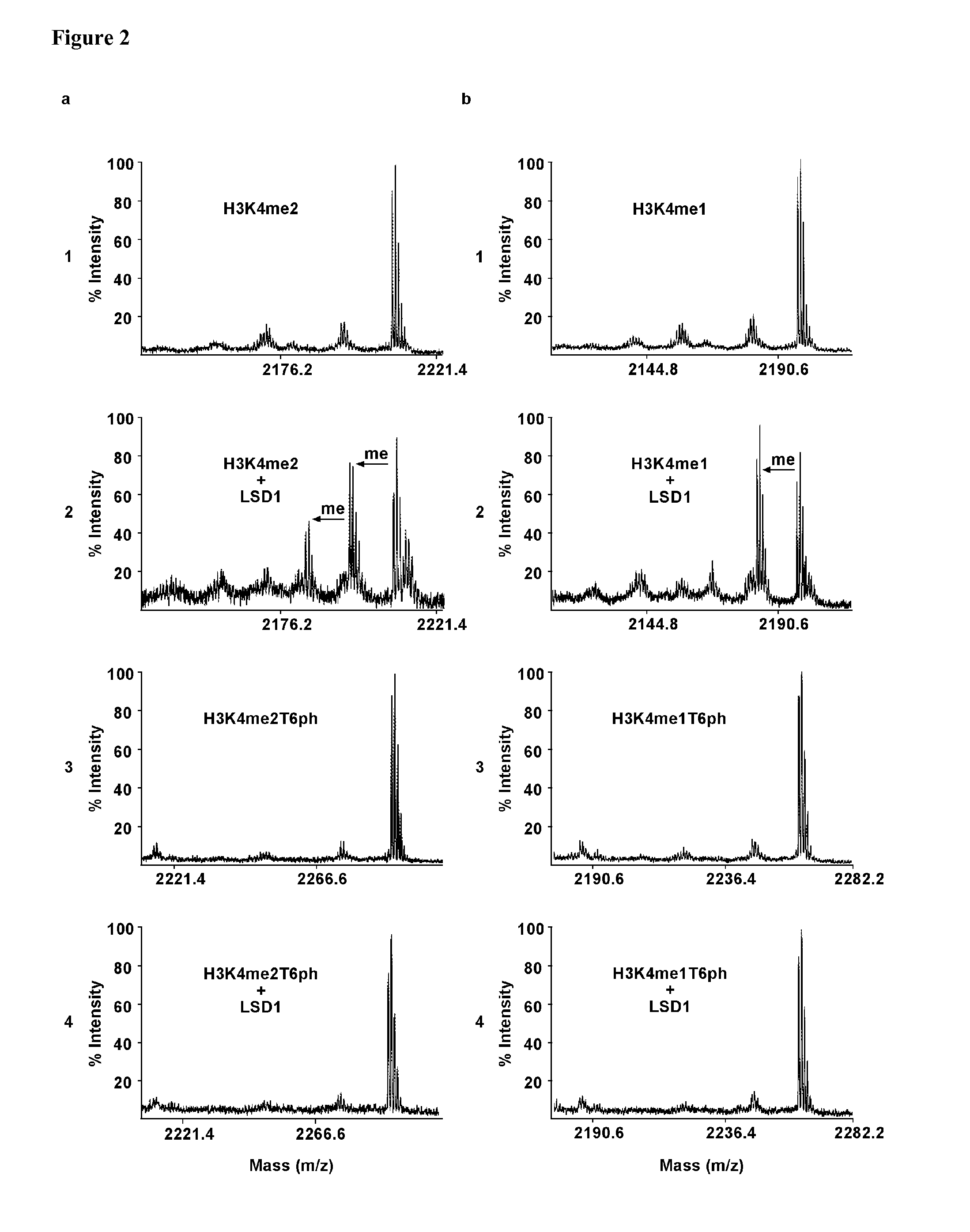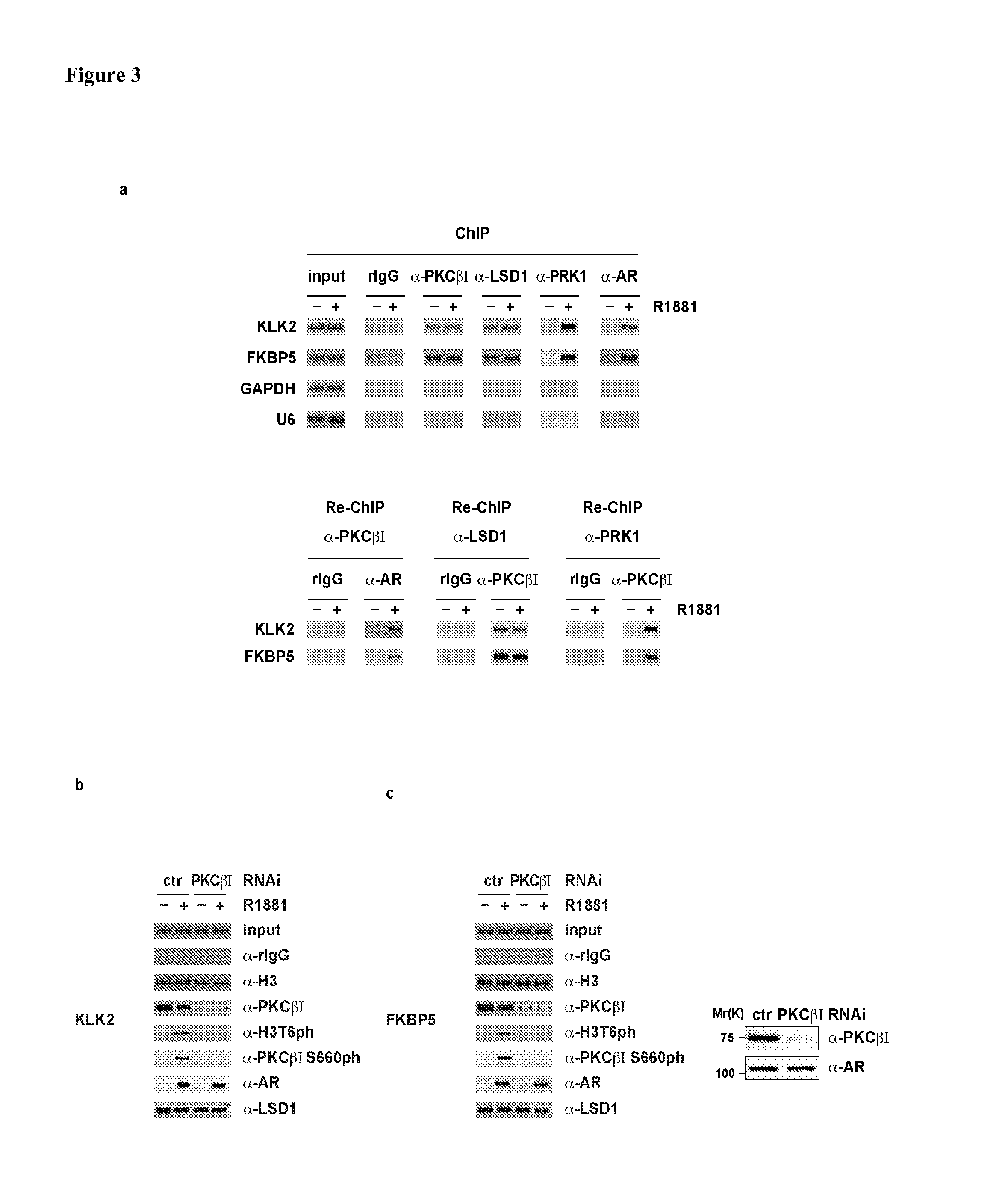Methods and Compounds for the Diagnosis and Treatment for Cancer
a cancer and compound technology, applied in the field of in vitro methods for detecting cancer, can solve the problems of false positive or negative, high risk of side effects, and test that does not allow the differentiation of benign prostate hyperplasia, non-aggressive prostate cancer and aggressive prostate cancer, etc., and achieve the effect of inhibiting expression or activity
- Summary
- Abstract
- Description
- Claims
- Application Information
AI Technical Summary
Benefits of technology
Problems solved by technology
Method used
Image
Examples
example 1
H3T6 is Phosphorylated by PKCβI
[0244]To identify putative H3T6 kinases, in vitro kinase screens were performed by incubating nucleosomes purified from HeLa cells with 97 recombinantly expressed, purified kinases (FIG. 5). Western blot analysis performed with antibody specific to phosphorylated H3T6 (α-H3T6ph) demonstrates that only PKCα, 131 and 132 phosphorylate nucleosomes at H3T6 (FIG. 1a). PKCα,β1 and β2 specifically target H3T6 but not threonine 3, serine 10, or threonine 11 of histone H3 (H3T3, H3S10, H3T11, respectively) (FIG. 1a). Specificity of the antibodies was verified (FIG. 6). Western blot analysis performed with α-PKCα, β1 or β2 antibodies shows that in LNCaP human prostate cancer cells only PKCβI is expressed (FIG. 7). Therefore, all further studies were continued with PKCβI. To corroborate in an independent approach that PKCβI exclusively phosphorylates H3T6, PKCβI was incubated with recombinant, purified GST-H3 or GST control proteins in the presence of [γ-32P]ATP....
example 2
Phosphorylation of H3T6 Blocks the Demethylation of H3K4 Methyl Marks
[0245]Demethylation assays were performed with di-, and monomethyl H3K4 peptides either unmodified at T6 (H3K4me2 and H3K4me1) or phosphorylated at T6 (H3K4me2T6ph and H3K4me1T6ph) and recombinant, purified LSD1 (FIG. 2a, b and FIG. 8). Following the demethylation assay, the peptides were analysed by mass spectrometry. The robust demethylation of H3K4me2 observed in the presence of LSD1 (FIG. 2a, compare panels 1 and 2) is completely blocked when the peptides are phosphorylated at T6 (FIG. 2a, compare panels 3 and 4). Likewise, demethylation of H3K4me1 by LSD1 is completely abrogated in the presence of phosphorylated T6 (FIG. 2b, panels 3 and 4). Since LSD1 only removes mono- and dimethyl marks1, 2, it was tested whether phosphorylation at H3T6 also blocks demethylation of tri-, and dimethyl H3K4 (H3K4me3 and H3K4me2) by members of the KDM5 family of JMJC domain-containing demethylases such as JARID1B / KDM5B9. Recom...
example 3
PKCβI and LSD1 form a Complex on Chromatin in a Ligand-Dependent Manner
[0246]Western blot analysis performed with anti-PKC α, β1 or β2 antibodies indicates that only PKCβI is expressed in LNCaP cells (FIG. 7). Therefore, it was investigated whether PKCβI is present at AR target genes and phosphorylates H3T6 in vivo. To analyse first whether PKCβI binds to promoters of AR target genes, LNCaP cells were subjected to chromatin immunoprecipitation (ChIP) in the presence or absence of the AR agonist R1881. PKCβI specifically associates with the androgen response elements (AREs) located in the promoters of the KLK210 and FKBP511 genes (FIG. 3a, upper panel). Association of PKCβI with AR target promoters is specific since DNA from neither GAPDH nor U6 promoters is enriched (FIG. 3a, upper panel). PKCβI binds to chromatin in a ligand-independent manner similar to LSD1 (ref2 and see FIG. 3a, upper panel). In comparison, Protein-kinase-C-related kinase 1 (PRK1) and AR bind chromatin only in a...
PUM
| Property | Measurement | Unit |
|---|---|---|
| pH | aaaaa | aaaaa |
| pH | aaaaa | aaaaa |
| pH | aaaaa | aaaaa |
Abstract
Description
Claims
Application Information
 Login to View More
Login to View More - R&D
- Intellectual Property
- Life Sciences
- Materials
- Tech Scout
- Unparalleled Data Quality
- Higher Quality Content
- 60% Fewer Hallucinations
Browse by: Latest US Patents, China's latest patents, Technical Efficacy Thesaurus, Application Domain, Technology Topic, Popular Technical Reports.
© 2025 PatSnap. All rights reserved.Legal|Privacy policy|Modern Slavery Act Transparency Statement|Sitemap|About US| Contact US: help@patsnap.com



